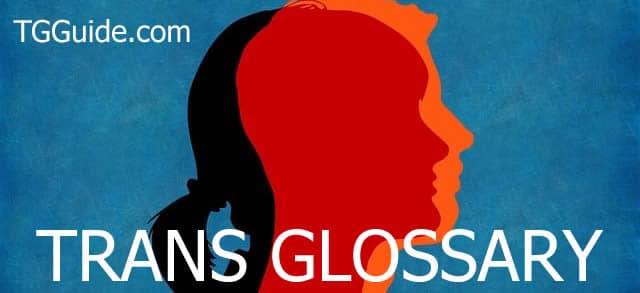Trans Glossary
This Trans Glossary is intended to provide a resource for people who are looking to understand the nuanced language associated with the transgender community. We include a range of terms that are commonly used to describe gender identity, expression, and the trans experience.
It’s important to note that the terms used in the transgender community are constantly evolving and changing, and everyone’s experience is unique. This glossary is an effort to provide a snapshot of the language in use at this time, but it’s essential to approach conversations about gender identity with respect, openness, and a willingness to learn.
Transgender Terms and Definitions
Agender: A person who does not identify as having a gender.
Androgenous: A person who has a combination of both male and female characteristics.
Assigned Gender: The gender originally assigned at birth based on primary sex characteristics.
Being Read: Refers to a trans person who has been recognized as being cross-dressed.
Bigender: A person who identifies with two (or more) genders.
Binary: Binary refers to gender that conforms to the traditional male or female role.
Binding: The use of compression to bind down a person’s breasts, typically in order to appear masculine.
Chaser: Refers to a person who is attracted to and pursues transgender people for sexual encounters.
Cisgender: An adjective used to describe individuals whose gender identity aligns with the sex they were assigned at birth.
Cis Man: A person who was assigned male and birth and continues to identify with that gender role.
Cis Woman: A person who was assigned female and birth and continues to identify with that gender role.
Cross-dressing (CD): The practice of wearing clothing and accessories that are typically associated with the opposite gender.
Deadname: A term used to refer to a transgender person’s name given at birth, that they no longer use, and they can bring discomfort.
Gender Affirming Surgery (GAS): A term that is increasingly used to describe surgical procedures that align a person’s physical characteristics with their gender identity. This term emphasizes that the goal of the surgery is to affirm and support a person’s gender rather than to “reassign” it.
Gender Dysphoria: A condition characterized by significant distress resulting from a mismatch between a person’s gender identity and their assigned sex.
Gender Expression: The ways in which a person presents their gender to the world through their appearance, behavior, and mannerisms.
Gender Identity: A person’s internal sense of their own gender. This can be different from the sex they were assigned at birth and can include identities such as transgender, non-binary, and gender variant.
Genderfluid: A person who feels most comfortable presenting a flexible gender expression, where they may present as either male, female or some combination of both.
Gender Reassignment Surgery (GRS): A general term used to describe a wide range of surgical procedures that alter a person’s physical characteristics to align with their gender identity. This can include procedures such as breast augmentation or removal (for transmen and transwomen respectively), as well as genital surgery.
Genderqueer: Refers to a person who identifies outside a binary gender role. May also be used to define a person’s identity.
Gender Neutral: A person who feels they don’t belong in either traditional gender role of male or female.
Gender Nonconforming: A term used to describe individuals whose gender identity falls outside of the traditional binary of male and female.
Gender Role: A social construct of the behavior, appearance and normal presentation expected from those perceived as a certain gender.
Gender Variant: A term used to describe individuals whose gender identity falls outside of the traditional binary of male and female.
Hormone Replacement Therapy (HRT): A medical treatment that involves taking hormones to change the secondary characteristics of one’s body.
Intersex: A term used to describe individuals who are born with physical characteristics that do not fit typical definitions of male or female.
LGBTQ+: An acronym that stands for lesbian, gay, bisexual, transgender, and queer or questioning.
Misgender: Referring to someone with pronouns that do not match their internal gender identity. Often used as a form of harassment.
Non-binary: A term used to describe individuals who do not identify as exclusively male or female.
Non-Op: A term used to describe a transgender person who has not undergone any surgeries.
Outing: The act of revealing someone’s transgender identity without their consent. This can be a dangerous and harmful action, and it’s important to always respect a person’s right to privacy.
Packing: Wearing a prosthetic penis to give the appearance of having a male appendage.
Pangender: Pangender is a nonbinary gender identity where the person may identify as two or more gender, all genders or a third gender.
Part-Time: A term used to describe a transgender person who identifies as their gender identity only some of the time.
Passing: The ability of a transgender person to be perceived as the gender they identify as.
Pronouns: Words that are used to refer to someone in place of their name, such as she/her, he/him, or they/them. It’s important to respect the pronouns that a person chooses for themselves.
Pre-Op: A term used to describe a transgender person who has not yet undergone any surgeries.
Post-Op: A term used to describe a transgender person who has undergone surgeries.
Questioning: A person who is trying to understand or is questioning their sexuality or gender identity.
Sex Change: A term that is considered outdated and not appropriate, because it suggests that a person can change their sex, which is not possible.
Sexual Orientation: Refers to the gender(s) a person is attracted to sexually and romantically. Is different from gender identity.
Stealth: A transgender person who strives to blend into mainstream society and not be openly trans.
Trans: An abbreviated term for transgender. A person whose gender identity is different from that assigned at birth.
Trans Ally: A straight person who stands up for the rights of the transgender community.
Transfeminine (MtF): A term used to describe individuals who were assigned male at birth but identify as more feminine.
Transgender (TG): An adjective used to describe individuals whose gender identity does not align with the sex they were assigned at birth.
Transman: A transgender person who was assigned female at birth but identifies as male.
Transmasculine (FtM): A term used to describe individuals who were assigned female at birth but identify as more masculine.
Transmisogyny: An intersection of misogyny and transphobia along with the discrimination and oppression faced by transgender women.
Transphobia: An irrational fear, loathing and/or discrimination against transgender people.
Trassexual (alt spelling Transexual): A person who is receiving hormone therapy and/or surgical transition to facilitate their transition to their internal gender identity.
Transvestite: An outdated term used to describe a person who crossdresses for sexual pleasure. Crossdresser is now the preferable term.
Transwoman: A person who was assigned male at birth but identifies as female.
Two-Spirit: A term originating from the American Indian peoples, refers to various gender identities outside the binary.
Tucking: Refers to various techniques to bind as to remove or minimize the appearance of penis and testicles.
Trans Terms and Definitions Evolve Over Time
The terms used in the transgender community are constantly evolving and changing. It’s essential to understand that everyone’s experience is unique and may use different terms to describe their identity. It’s important to approach conversations about gender identity with respect, openness, and a willingness to learn.
Did we miss any terms? Did we miss the mark on anything? We welcome your comments below.
About the Author
Ellie P. Wilson, Transgender Rights Reporter

With her own experience as a transwoman, she brings a unique and personal perspective to her coverage of transgender rights and news stories affecting transgender people. Whether it’s covering the latest developments in transgender rights or uncovering the impact of new policies and initiatives on the trans community, Ellie approaches her stories with empathy for the trans community.
Contact Ellie P. Wilson: ElliePWilson@teamdnp.com
Link to My Bio: Ellie P. Wilson

Great article…..I am bi sexual and a crossdresser. How would I define myself?
Also… is just coming out bi enough, since I generally only cross dress at home?
Thanks for commenting on our trans glossary. Defining ourselves is a very personal decision. In your case it seems accurate to define yourself as bisexual. It is entirely up to you when and if you will divulge that you cross dress at home.